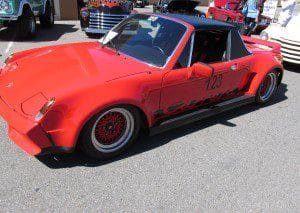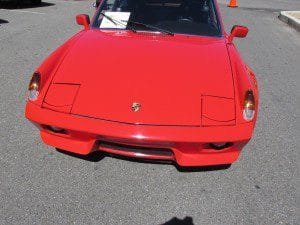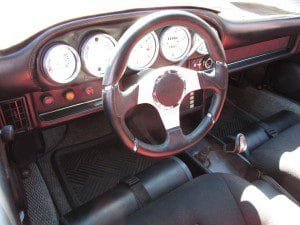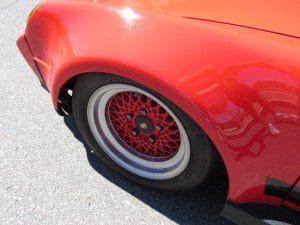The Porsche 914 as featured in this article was among the 914 models built from 1970 through 1976. The car was first unveiled in 1969 at the Frankfurt Auto Show.

This model was to replace the Porsche 912 and was an effort to appeal to the mass car market. Not that Porsche was ever thought of as an automobile for the masses but this was their intent with the 914. The 1974 Porsche also represents a close collaboration with Volkswagen as the automaker had done once before.
A Low Priced Sports Car
The Porsche 914 was meant to be a light weight sports car with rear wheel drive that was intended to be affordable to many. The collaboration between Porsche and Volkswagen would also allow for fewer manufacturing costs. When the Porsche 914 was first introduced in 1970 the car was priced at about $3,500. Not a bad price at all even in 1974 with a sports car fashioning a Porsche emblem.
Porsche 914 Styling
The Porsche 914 was without a grille but did feature flip-up headlights. One body style was offered and that was the notchback coupe with a lift off roof panel. Some of the car’s interior resembled the Porsche 911 but a good deal of VW hardware was also used. This Porsche model also featured two trunks. Not bad at all for a sports car.

The Porsche 914 engine was placed behind the cabin.
Porsche 914 Sales and Marketing
Volkswagen’s interest in this car was that the automaker needed something different than it’s Beetle. A sports car would fit the bill but they needed the experience of Porsche to enter the field. Make no mistake however, while VW was a partner in this project and they were the one’s who marketed the car, the Porsche 914, regardless of it being called at the time in Europe, a VW-Porsche, the sports car was considered a Porsche by the American car buying public.
The arrangement by the two European automakers certainly was different. The Porsche 914 was the only Porsche model that the automaker gave up it’s own rights to market. The agreement between the two automakers was even more complicated when the chairman of VW passed away in 1968 prior to actual production.

Quite a lot has been written about how disappointing the Porsche 914 was, especially in sales. The fact is that the Porsche 914 was received pretty well in the U.S. Better than it was overseas but still not to what was hoped for. Some design flaws were uncovered with the first models. They were remedied by Porsche but as often happens, bad press has a habit of snowballing and this did hurt sales.
The press at the time seemed to fixate on the VW / Porsche collaboration as a negative without giving the car excellent grades on engineering. The car structurally was built very well.
One drawback pointed out however was that the Porsche 914 was equipped with a 1.7 liter VW flat four engine and this wasn’t thought by many to be what sports cars are about. There were also problems with the transmission linkage which hurt engine performance even more. Some also suggested that access to the engine was difficult and that the cabin space was limited. The cabin space had good width but the length/ leg area was a bit short. On the plus side the removable targa top was made to easily store in one of the trunk compartments.

A New Engine and a New Price
By the 1973 model year, things changed for the better. The 1973 Porsche 914 came out with a 2.0 liter six cylinder engine. The transmission issue was also fixed and the remainder of the car was pretty much the same. The new six cylinder engine was very well received and seemed to change many perceptions regarding the 914. Press reviews of the car also changed entirely simply with adding the new engine. Also changed was the price tag. The 1973 911 had a price tag north of $5,000. Prices in the U.S. also shot up in part because of the exchange rate at the time.
1974 Porsche 911 Specifications
As mentioned above, the Porsche 914 introduced in 1970 had a 1.7 liter VW air cooled flat-four engine. A flat-four has two banks of two cylinders each arranged horizontally. Beginning in 1973 the Porsche 914 sported a 2.0 liter six. This change appeared to satisfy both car buyers and auto critics. All engines had cast-aluminum cylinder heads and Bosch electronic fuel injection.

Transmission was a five speed manual.
The Porsche 914 had independent suspension with a front torsion bar which was a duplicate of the 911’s.
The Porsche 914 came with front disc brakes.
Porsche 914 dimensions included a 96.5 inch wheelbase, a length of 158.0 inches, a height of 48.0 inches and a weight of about 2,100 lbs. The 914 was lower than the 911 Porsche by four inches.
One production figure seen for the Porsche 914 was 115,596 cars. This was the total over the entire production run. 1974 Porsche 914 production was 21,370 vehicles.
Compare the 1974 Porsche 914 to the cars on the AutoMuseumOnline articles linked below…

The Porsche 914 Makes a Good Collector Car
It took awhile but the Porsche 914 has become a popular sports car among collectors. Since they are not the easiest automobiles to find because of the relatively low production number, they have had rising value. The lowest production year was the model’s last, 1976. Even these low numbers however are more than total Porsche 911 production. If you’re looking for a Porsche 914 to restore your challenge will be to find one without rust or without bad rust. The cars did gain a reputation of above average rusting.
Two well known Porsche car clubs which are always good resources for owners and prospective owners include the Porsche Club of America at www.pca.org and the Porsche 914 Owners Association at www.porsche914.org
One of the more popular Porsche 914’s you’ll want is the 1973 or 1974 model with the 2.0 liter six cylinder engine. These were the models that had the original problems ironed out.
As of this date, price tags on mint conditioned Porsche 914’s range from the mid teens upward. The asking prices today cover a wide range. Low mileage obviously helps as does a rust free chassis. Originality is also important to price. You’ll also find showroom condition restored 914’s in the $30,000 range upwards.
(Article and photos copyright 2013 AutoMuseumOnline)